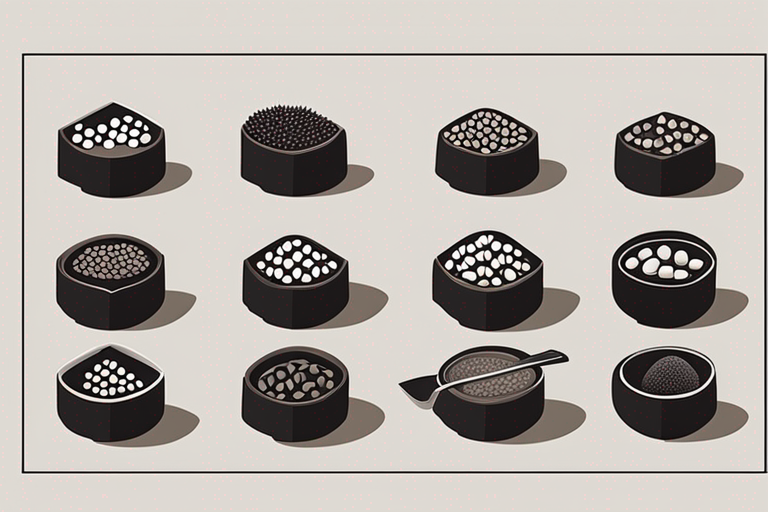
The Ultimate Guide to Properly Storing Black Truffles
Get Your Free Food Safety Cheat Sheet
30 most common foods with instant answers. Print it and stick it on your fridge—completely free!
The Ultimate Guide to Black Truffles: Storage, Freshness, and Enjoyment
Black truffles are a highly sought-after delicacy renowned for their intense aroma and flavor profile. To fully appreciate the unique taste of black truffles, it is crucial to store them correctly to maintain their freshness and quality. In this comprehensive guide, we will delve into the best practices for storing black truffles, identifying signs of spoilage, and maximizing the enjoyment of these prized fungi.
Understanding Black Truffles
Black truffles are prized for their robust aroma and earthy flavor, making them a favorite ingredient in gourmet cuisine. When selecting black truffles, look for the following characteristics to ensure freshness:
- Appearance: Firm texture, dark black exterior, slightly wrinkled surface, and an earthy aroma.
- Touch and Feel: The truffle should feel heavy for its size and firm to the touch, not soft or mushy.
- Smell: A complex aroma with hints of garlic, earthiness, and musk.
- Taste: Rich, earthy, and nutty flavor profile.
Why Proper Storage Matters
Black truffles are highly perishable and require specific storage conditions to prevent spoilage and preserve their aromatic properties. Factors such as temperature, humidity, airflow, and light exposure can impact the storage of black truffles. By following the right storage techniques, you can extend the shelf life of black truffles and ensure they maintain their exquisite taste.
Tips for Storing Black Truffles
To maintain the freshness and flavor of black truffles, consider the following storage tips:
1. Choose the Right Storage Container
Opt for a container that allows for proper air circulation and moisture control. Avoid airtight containers to prevent condensation and mold growth. Ideal options include mesh bags or containers lined with paper towels.
2. Refrigeration is Key
Store black truffles in the refrigerator at a consistent temperature between 32-37°F (0-3°C). Avoid placing them in the coldest part of the fridge to prevent damage. Refrigeration helps maintain freshness and slows down the degradation process.
3. Enhance Aroma with Rice or Eggs
Store black truffles with uncooked rice or eggs in the same container to absorb excess moisture and preserve the truffle's flavor profile.
4. Regular Inspection and Cleaning
Check black truffles regularly for any signs of spoilage such as mold or soft spots. Remove affected truffles promptly and gently wipe them with a damp cloth to remove dirt before returning them to the fridge.
5. Use Promptly for Optimal Flavor
For the best culinary experience, use black truffles within a week of purchase to enjoy their intense aroma and flavor. Delayed consumption can lead to a reduction in taste and aroma intensity.
Signs of Spoilage and Proper Storage
Despite their robust flavor, black truffles can deteriorate over time. Here are signs indicating that a black truffle has gone bad:
- Mold Growth: Visible mold on the surface or inside the truffle.
- Soft or Spongy Texture: Loss of firmness indicates spoilage.
- Foul Odor: Unpleasant smell, different from the typical aroma.
- Dry or Wrinkled Appearance: Dehydrated or shriveled truffles.
- Slimy or Discolored Surface: Signs of bacterial growth and spoilage.
To prevent premature spoilage, follow these additional storage tips:
- Refrigeration: Store in the refrigerator in a paper towel-lined container.
- Use Rice or Eggs: Absorb excess moisture to preserve texture.
- Regular Inspection: Check for spoilage signs and remove affected truffles promptly.
- Prompt Use: Consume fresh for optimal flavor, or freeze for long-term storage.
Review and Credibility
This comprehensive guide provides valuable insights into the proper storage and maintenance of black truffles to enhance your culinary experience. By following the outlined storage tips and recognizing signs of spoilage, you can savor the exquisite taste of black truffles in your dishes. For further information and resources on black truffles, visit [here](/food/black truffle).

Authoritative Food Safety References
These agencies and university labs inform every tip and health precaution we publish.
USDA FoodKeeper – Cold Storage Guidelines
Official refrigerator, freezer, and pantry timelines maintained by the U.S. Department of Agriculture.
Visit USDA FoodKeeperFDA Produce Safety Rule & Grower Guidance
Field-to-fridge handling practices that prevent contamination of fruits, vegetables, and leafy greens.
Visit FDA Produce SafetyCDC Foodborne Illness Prevention Hub
Surveillance-backed guidance on pathogens, symptoms, and steps to reduce foodborne illness risk.
Visit CDC Food SafetyUC Davis Postharvest Technology Center
University research detailing optimal storage atmospheres for produce after harvest.
Visit UC Davis PostharvestPenn State Extension – Home Food Preservation & Safety
Peer-reviewed extension bulletins on safe canning, chilling, and reheating practices.
Visit Penn State ExtensionCan black truffles be frozen for long-term storage?
How long do black truffles last when properly stored?
What is the best way to clean black truffles before storing them?
Can black truffles be stored with other foods?
Get Your Free Food Safety Cheat Sheet
30 most common foods with instant answers. Print it and stick it on your fridge—completely free! Want more? Upgrade to the complete guide with 70+ foods.
Scan your food directly and get instant safety info using our AI-powered camera feature.